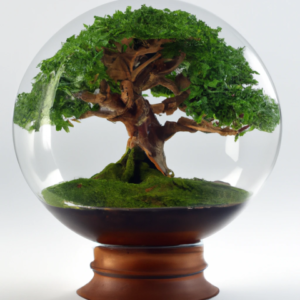I still remember feeling disappointed when my first terrarium failed because I chose a beautiful but completely wrong container. The narrow opening made it impossible to arrange plants properly, and the tinted glass blocked essential light from reaching my succulents.
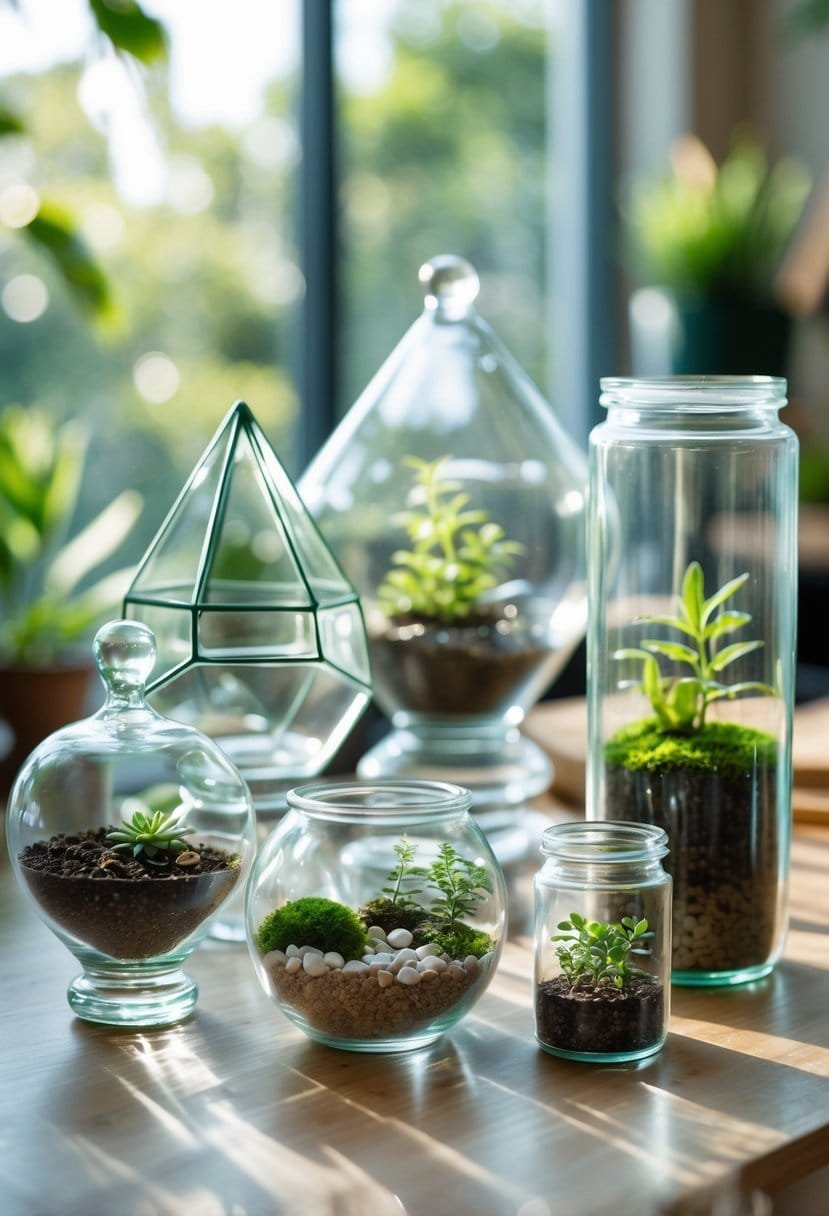
The perfect glass container for your terrarium has a wide opening, clear or lightly tinted glass, and enough space for plants to have at least one-third of the container as free growing room. Choosing the right container is the foundation of a successful terrarium and affects plant health and ease of maintenance.
Your container choice determines what plants you can grow and how your terrarium looks in your home. It also influences whether your plants will thrive or struggle.
Understanding the different types of terrariums, why glass works better than other materials, and what features promote healthy plant growth will help you make the right choice for your space and skill level.
Key Takeaways
- Glass containers with wide openings and clear walls provide the best light and easiest access for planting and maintenance.
- Container size and shape impact plant health, with larger containers offering better air circulation and root space.
- Matching your container style to your plant selection ensures both aesthetic appeal and proper growing conditions.
Understanding Terrarium Types
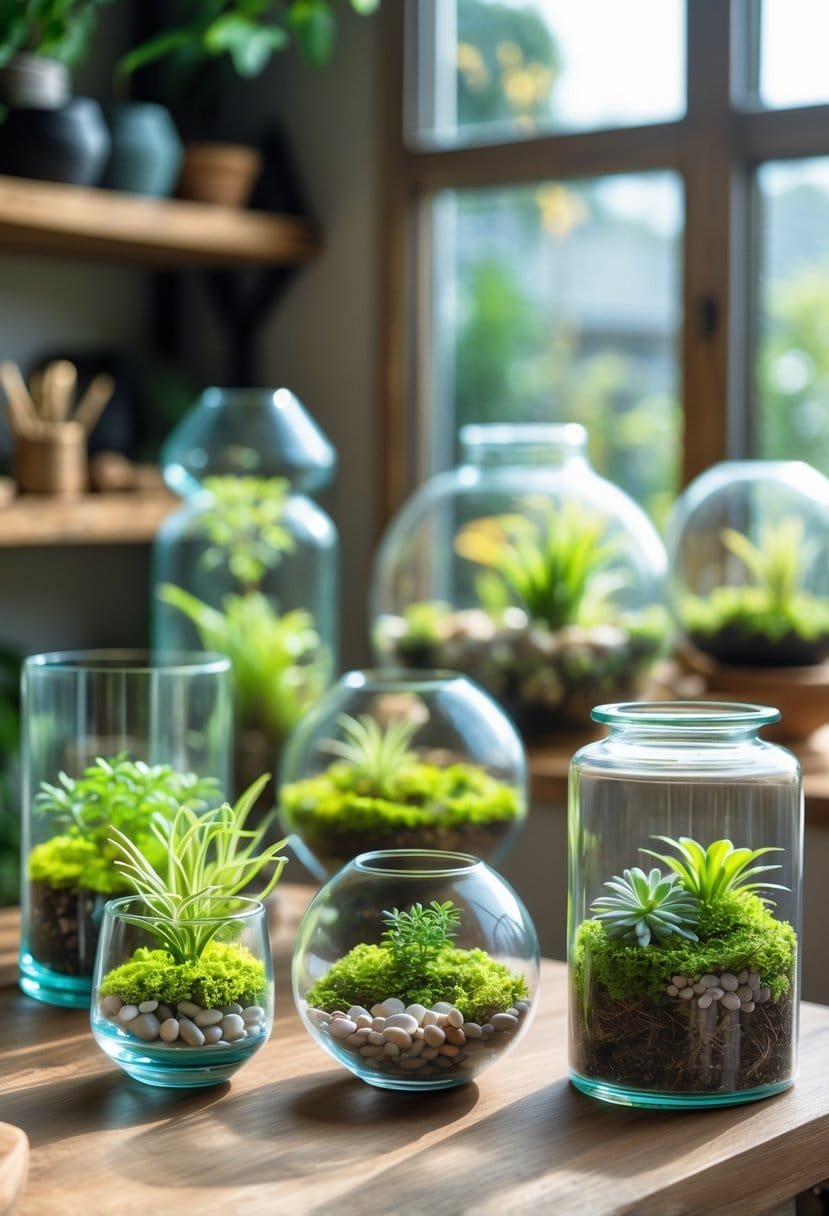
Your choice of terrarium type directly affects your container selection and plant options. Closed terrariums create humid environments for tropical plants, while open terrariums suit dry-loving plants like succulents and cacti.
What is a Closed Terrarium?
A closed terrarium is a sealed glass container that creates its own water cycle. The lid traps moisture inside and creates a humid environment like a greenhouse.
Key characteristics:
- Has a lid or cover
- High humidity levels (80-90%)
- Minimal watering needed
- Creates a self-sustaining ecosystem
Water evaporates from the soil and plants, then condenses on the glass walls. The water drops back down to the soil, creating a continuous cycle.
I suggest choosing containers with effective sealing![]() using cork or rubber lids. The container must be airtight to keep humidity levels high.
using cork or rubber lids. The container must be airtight to keep humidity levels high.
Best plants for closed terrariums:
- Tropical plants like small palms and prayer plants
- Moss varieties that thrive in moisture
- Ferns such as maidenhair and button ferns
- Small orchids and begonias
What is an Open Terrarium?
An open terrarium has no lid or cover, so air flows freely in and out. This creates a drier environment similar to desert or arid conditions.
Key characteristics:
- No lid or cover
- Low humidity levels (30-50%)
- Requires regular watering
- Better air circulation
Open terrariums need containers with wide openings for good airflow. The plants rely on you for watering since there’s no water cycle inside.
Best plants for open terrariums:
- Succulents like echeveria and jade plants
- Cacti of various sizes and shapes
- Air plants (tillandsia species)
- Drought-tolerant herbs like rosemary
Matching Plants to Terrarium Types
Choosing the wrong plant for your terrarium type will harm your plants. Tropical plants will dry out in open terrariums, while succulents will rot in closed ones.
For closed terrariums, choose:
- Plants that love high humidity
- Species that stay small
- Varieties with similar water needs
For open terrariums, select:
- Drought-tolerant plants
- Species that prefer good air circulation
- Plants that can handle lower humidity
When selecting containers for closed eco systems![]() , make sure the glass is clear for proper light. Your plants need full spectrum light to photosynthesize.
, make sure the glass is clear for proper light. Your plants need full spectrum light to photosynthesize.
Container size matters:
- Small containers work for moss terrariums
- Large containers suit tropical plants with room to grow
- Medium containers handle most ferns and small succulents
Match your plant choice to the terrarium type first, then select the right container size and style.
Why Glass is the Ideal Material
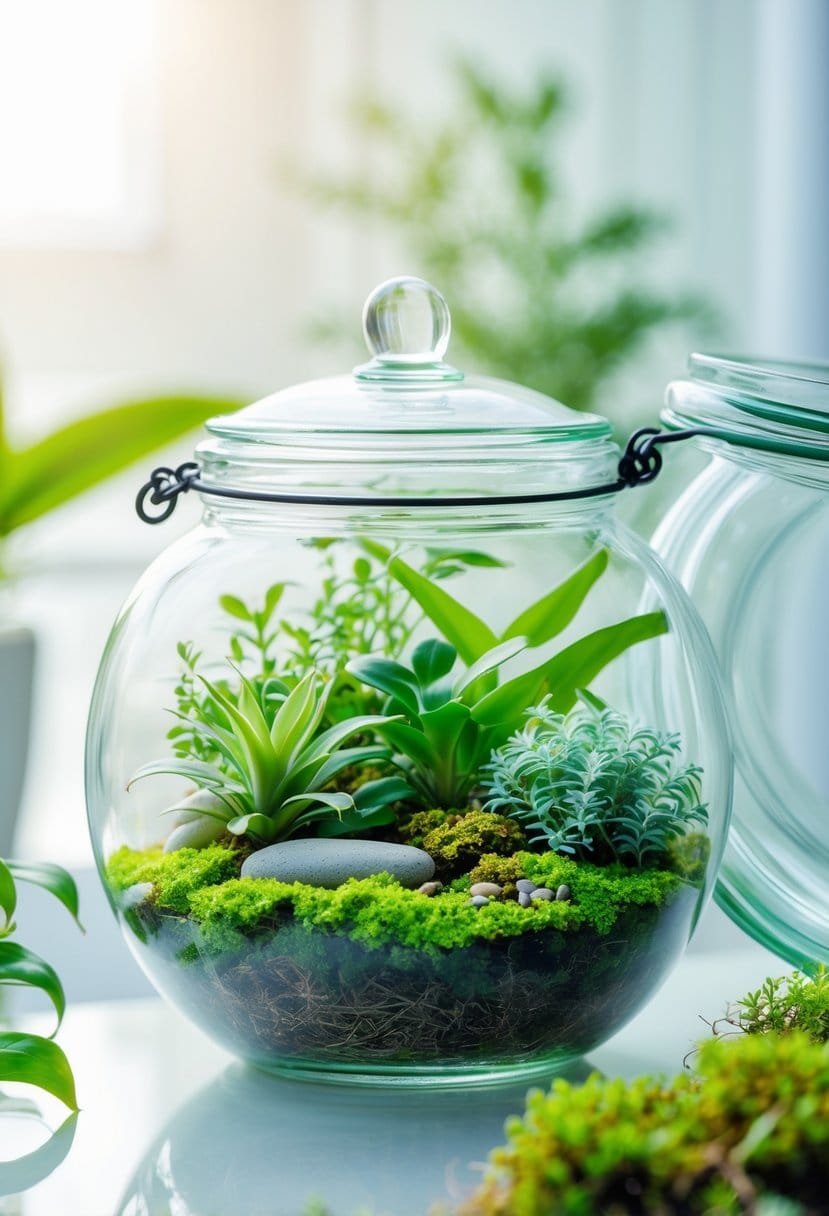
Glass stands out as the best choice for terrarium containers because of its transparency, durability, and plant-friendly properties. Glass provides optimal light transmission and maintains a stable environment for your plants.
Benefits of Glass Containers
Perfect Light Transmission
Glass lets maximum light reach your plants without distortion. This clarity helps plants photosynthesize and allows you to enjoy your terrarium.
Transparent containers show off moss, ferns, and other plants beautifully.
Superior Durability
Quality glass containers last for years with proper care. They resist scratches better than plastic and won’t become cloudy over time.
Glass jars and fish bowls keep their clear appearance. This makes glass containers a smart long-term investment for your indoor garden.
Chemical-Free Environment
Glass is inert and won’t leach chemicals into your soil or affect plant health. This keeps your terrarium ecosystem healthy.
Mason jars and wine bottles made from glass provide a pure environment. Your plants grow in a container that won’t introduce harmful substances.
Glass vs. Other Materials for Terrariums
Glass vs. Plastic
Plastic terrarium containers may seem convenient, but they scratch easily and sometimes become cloudy. This affects the appearance of your terrarium.
Glass maintains its clarity. Plastic can also retain odors and warp in sunlight.
Glass vs. Metal
Metal containers block light completely and rust when exposed to moisture. This makes them unsuitable for plant growth.
Glass containers allow essential light to reach your plants. Metal containers create dark conditions that harm most terrarium plants.
Glass vs. Ceramic
Ceramic containers often lack transparency and may have glazes that affect plant health. They’re also heavier and more likely to crack than glass.
Glass jars offer strength and visibility. Ceramic containers hide your plants and can develop cracks from temperature changes.
Key Factors in Choosing a Glass Container
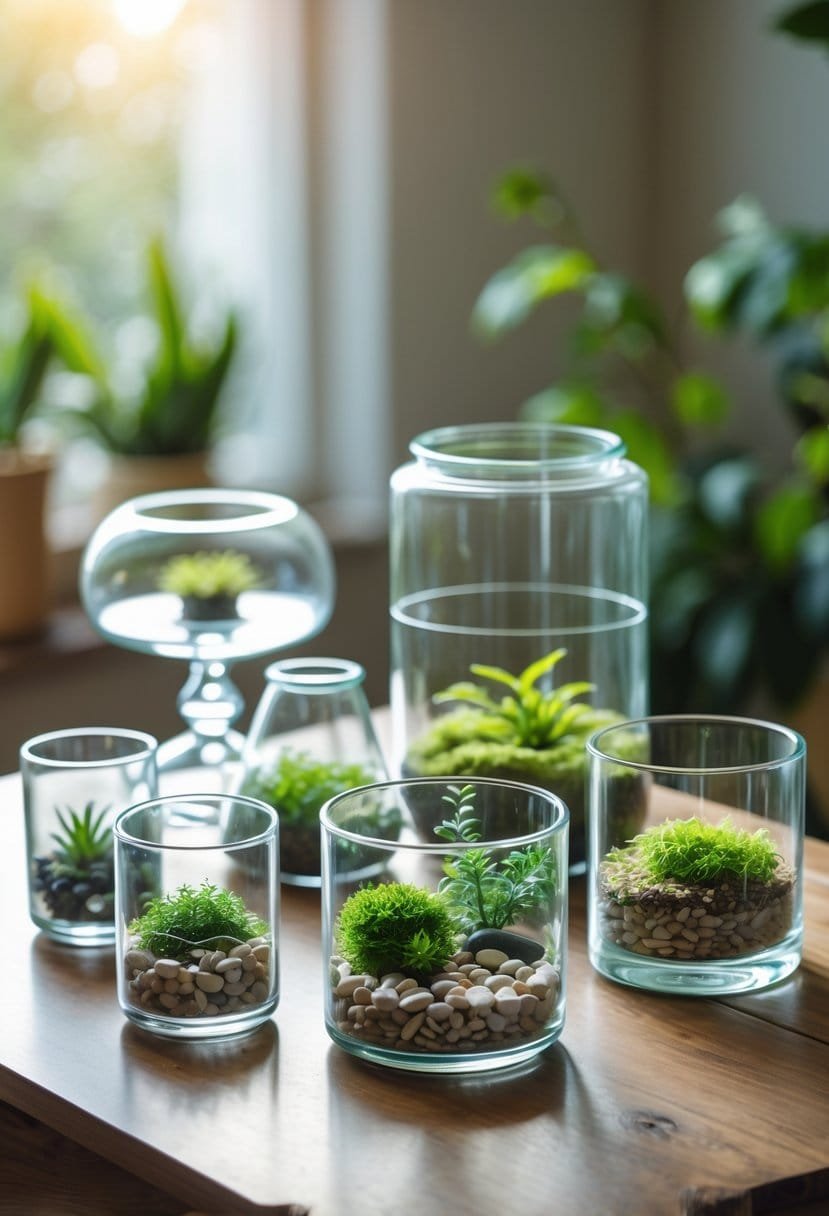
The right glass container is essential for your terrarium’s success. Transparency affects light penetration for healthy plant growth![]() , and size and shape determine what plants will thrive.
, and size and shape determine what plants will thrive.
Transparency and Light Penetration
Clear glass gives your plants the best chance to photosynthesize. I always choose containers with high transparency because plants need consistent light to grow.
Scratched or cloudy glass blocks essential light. This reduces plant health over time.
Colored glass limits light penetration. Red or blue tinted containers filter out specific light wavelengths that plants need. Green glass blocks the red light that plants use most.
Light Requirements by Plant Type:
- Moss: Low to medium light through clear glass
- Ferns: Bright, indirect light with maximum transparency
- Succulents: High light penetration for open terrariums
Thick glass walls reduce light transmission more than thin walls. I prefer containers with walls under 5mm thick for better light penetration.
Size and Shape Considerations
Container size affects what plants you can grow. Large glass jars or bowls with wider bases give plants more room to breathe and flourish![]() .
.
Size Guidelines:
- Small containers (under 6 inches): Perfect for moss-only displays
- Medium containers (6-12 inches): Ideal for single small plants with moss
- Large containers (over 12 inches): Support multiple plants and complex layouts
Tall containers work best for upright plants like small ferns or air plants. Wide, shallow containers suit spreading plants like moss or groundcovers.
Tropical-style terrariums need containers with enough space for plants to grow upward and outward![]() . I avoid containers where plants will outgrow the space within six months.
. I avoid containers where plants will outgrow the space within six months.
Round containers create natural viewing angles from all sides. Rectangular containers work better against walls or in corners. The shape affects how I arrange plants.
Accessibility for Maintenance
Container opening size determines how easily I can maintain my terrarium. Containers with narrow openings make upkeep challenging![]() .
.
I need enough space to fit my hand comfortably for planting and pruning. Openings smaller than 4 inches make it hard to remove dead leaves or adjust plant positions.
Maintenance Tasks Requiring Good Access:
- Removing dead or yellowing leaves
- Adjusting plant positions as they grow
Wide openings let me use normal gardening tools. Narrow openings force me to use tweezers or chopsticks, which makes maintenance harder.
Containers with wider openings are better for beginners or anyone who prefers easier maintenance![]() . I can reach all areas of my miniature landscape without struggling.
. I can reach all areas of my miniature landscape without struggling.
Deep containers need wider openings than shallow ones. A 12-inch deep container needs at least a 6-inch opening for practical maintenance.
Container Styles and Unique Options
Modern terrarium enthusiasts can choose striking geometric designs that create stunning focal points. Creative builders can transform everyday items like wine bottles and mason jars into unique plant habitats.
Geometric Glass Terrariums
Geometric terrariums![]() offer clean lines and modern appeal. These containers feature angular shapes like pyramids, hexagons, and diamond forms.
offer clean lines and modern appeal. These containers feature angular shapes like pyramids, hexagons, and diamond forms.
Popular geometric styles include:
- Copper-framed pyramids
- Hexagonal glass boxes
- Diamond-shaped vessels
- Triangular hanging containers
I recommend choosing geometric containers with wide openings for easier planting. The angular design creates visual interest while giving plants proper space.
Many geometric options come with fitted lids for closed terrariums. The structured shape provides excellent stability and makes arranging plants simpler than curved containers.
These containers work well for minimalist plant displays. The sharp edges complement succulents and air plants.
Repurposed and Upcycled Containers
Repurposed containers add sustainability and character to terrarium projects. Mason jars are a popular choice for beginners because their wide openings and secure lids make planting easy.
Excellent upcycling options include:
- Wine bottles – Great for narrow bottle terrariums
- Fish bowls – Ideal for large plant displays
- Glass jars – Available in various sizes for different projects
- Large vases – Suitable for spacious root systems
Wine bottles challenge you to work with narrow openings, but special tools help create unique vertical displays. These projects reward your effort with striking results.
Fish bowls offer plenty of space for plant growth and are easy to maintain. Clear glass bowls allow for better light transmission than colored ones.
Clean all containers thoroughly before using them. Check for cracks or chips that could cause issues later.
Essential Features for Plant Health
The right container features help your terrarium thrive by controlling moisture, air circulation, and root health. Good ventilation and a proper drainage layer support healthy plant growth.
Ventilation and Sealing
Choose containers based on your plant types and their moisture needs. Closed terrariums need tight-fitting lids to maintain humidity for tropical plants like ferns and mosses.
Closed System Benefits:
- Maintains consistent moisture
- Creates a humid microclimate
- Reduces watering needs
- Ideal for tropical plants
Open terrariums work best for succulents and cacti that prefer dry conditions. These containers have no lid or use loose covers to allow air circulation.
Look for containers with cork or rubber seals when building closed systems. These materials create airtight environments and prevent harmful chemicals from leaching.
Test your container’s seal by adding water and checking for leaks. A well-sealed terrarium should keep condensation on the glass walls and not lose moisture quickly.
Drainage Layer and Substrate Selection
Create a drainage layer at the bottom of your terrarium container. This step prevents water from pooling around plant roots, which can cause rot and fungal problems.
Essential Drainage Materials:
- Small pebbles or gravel (1-2 inches)
- Activated charcoal (thin layer)
- Moss or fabric separator
- Appropriate substrate mix
Place activated charcoal above the pebbles to filter impurities from the water. This layer stops bacteria from growing and keeps the terrarium healthy.
Adjust substrate depth based on plant root systems. Shallow-rooted plants need 2-3 inches of growing medium, while deeper roots require 4-6 inches.
The substrate should drain well but hold some moisture. Mix potting soil with perlite or sand to achieve the right texture for your plants.
Pairing Plants with Containers
Different plants need specific container features to thrive in glass environments. Moisture-loving plants like mosses and ferns have different needs than drought-tolerant succulents and air plants.
Choosing Glass Containers for Mosses and Ferns
Closed terrariums with lids work best for mosses and ferns because these plants need consistent humidity. Glass containers that create a greenhouse effect help maintain the 70-80% humidity these species require.
Wide-mouth jars and fishbowls make planting and maintenance easier. The opening should be at least 4 inches wide for fern fronds and proper airflow.
Deep containers support fern root systems. Vessels that are 6-8 inches deep work well for ferns like Boston and maidenhair ferns.
Clear glass is better than colored glass for these shade-loving plants. Frosted glass is acceptable but may reduce light too much for healthy growth.
| Container Feature | Mosses | Ferns |
|---|---|---|
| Lid/Cover | Required | Preferred |
| Depth | 3-4 inches | 6-8 inches |
| Width | 6+ inches | 8+ inches |
| Glass Type | Clear/Frosted | Clear |
Best Glass Vessels for Succulents, Cacti, and Air Plants
Open containers without lids prevent moisture buildup that harms succulents and cacti. Avoid closed terrariums for these plants since they need good air circulation and low humidity.
Shallow, wide bowls suit most succulents because their roots spread horizontally. A 2-3 inch depth works well for plants like echeveria and jade.
Tall, narrow vessels are perfect for air plants since they don’t need soil. Place Tillandsia species on decorative stones or driftwood inside cylinder vases or hanging glass globes.
Clear glass maximizes light exposure for sun-loving plants. Succulents and cacti do best with maximum light through transparent walls.
Geometric terrariums create modern displays for these architectural plants. Angular glass shapes complement cacti and air plants while providing proper ventilation.
Tools and Accessories for Building Your Terrarium
Long tweezers let you place plants and decorations precisely in tight spaces. Small decorative items like stones, figurines, and moss help create a miniature garden atmosphere.
Tweezers and Planting Tools
Aquarium tweezers are useful for terrarium building. They come in straight and curved styles, with lengths from 10 to 15 inches.
Straight tweezers help place plants in open containers. Curved tweezers let you reach around obstacles and into corners of closed terrariums.
The extra length keeps your hands out of the container and prevents disturbing other plants. This also keeps your hands clean.
Use small paintbrushes for detailed work. They spread soil around delicate roots without causing damage.
A long-handled spoon moves soil and creates small holes for planting. These tools help keep your project neat and tidy.
Decorative Elements for a Miniature Garden
Small decorative stones create pathways and add texture to your garden. Use pebbles no larger than a quarter-inch across.
Moss adds natural green coverage between plants. It grows slowly and needs little care in humid terrariums.
Tiny figurines like mushrooms, animals, or fairy houses make charming focal points. Keep them under 2 inches tall so they don’t overshadow your plants.
| Decoration Type | Best Size | Purpose |
|---|---|---|
| Stones | Under 0.25 inch | Pathways, texture |
| Figurines | Under 2 inches | Focal points |
| Moss | Any size | Ground cover |
Small pieces of driftwood or bark create natural-looking landscapes. Colored sand can define different areas in your miniature garden.
Frequently Asked Questions
Container dimensions, glass types, and lid choices affect terrarium success. Shape influences plant growth, and glass color changes how much light plants receive.
What are the ideal dimensions for a glass terrarium container?
Choose containers that provide at least one-third of the space as free air above your plants. This allows for proper gas exchange and prevents overcrowding.
For beginners, start with containers at least 6 inches wide and 8 inches tall. Larger containers give you more freedom for plant placement and creative elements.
Smaller containers work for simple moss displays but need more careful monitoring.
Which glass type is best for maintaining terrarium plant health?
Clear glass is best for terrarium plant health because it lets in the full light spectrum. Plants need this light for photosynthesis and growth.
Thick, sturdy glass resists cracking from temperature changes. Mason jars and laboratory glassware are durable choices for long-term use.
Avoid thin glass that might break during maintenance. Containers should handle regular watering and pruning.
What factors should be considered when choosing a terrarium container with a lid?
The lid should create a proper seal to keep humidity inside your terrarium. Look for containers with tight-fitting lids that won’t warp.
Glass lids last longer than plastic ones. If your container doesn’t have a lid, use plastic wrap, custom-cut perspex discs, or cork stoppers as alternatives.
How does container shape impact the growth of terrarium plants?
Containers with uniform shapes like boxes or cylinders give plants consistent space and even substrate distribution. These shapes offer stable foundations for plant growth.
Narrow-based containers limit root space and drainage. This restriction can stunt plant growth and cause water problems.
Wide openings make planting and maintenance easier. Beginners should choose containers with openings at least 4 inches across.
Can colored glass be used for terrariums, and how does it affect plant growth?
Clear or green glass containers work best because they don’t block essential light wavelengths. Green glass is safe since plants reflect green light.
Other colored glass can filter out parts of the light spectrum that plants need. Blue, red, or amber glass may reduce plant growth and health.
Stick with clear or green-tinted glass for the best results. The look of colored glass isn’t worth the risk to plant health.
What are the pros and cons of using recycled glass containers for terrariums?
Recycled glass containers save money and help the environment. I often find great options at thrift stores and online marketplaces for much less than retail prices.
Wine bottles, mason jars, and old aquariums make excellent recycled terrarium containers. These containers are easy to find and often have unique shapes.
The main drawback is that size and style options are limited. You might need to wait longer to find the perfect container.
Some recycled containers have scratches or imperfections that affect visibility. I always check used glass carefully before buying it for my terrariums.
